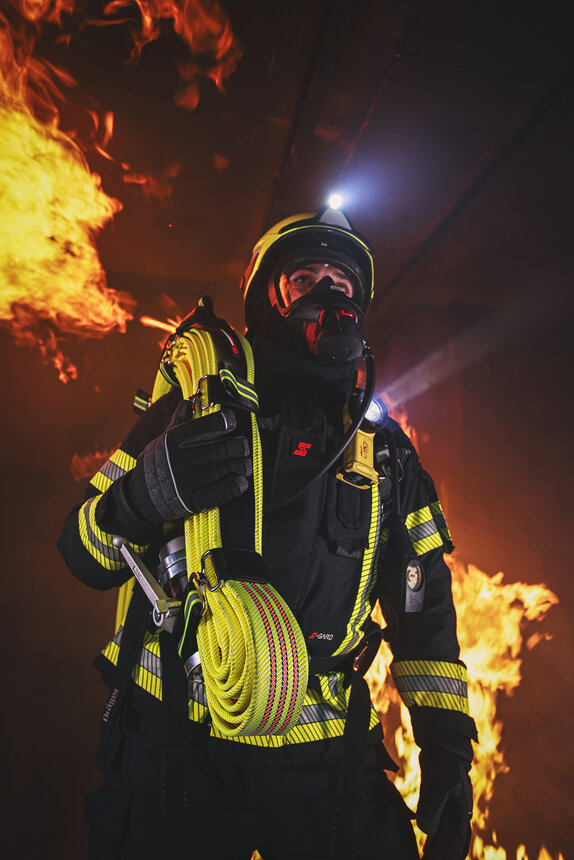Our quality promise as a german hose manufacturer since 1872 – your life insurance!
Our quality promise as a german hose manufacturer since 1872 – your life insurance!
Our TOP recommendations for fire hoseWhen firefighters battle flames and fearlessly tackle disasters, they have to have absolute faith. Faith in themselves, their team and their equipment – so that every individual can be protected.
For more than 150 years we have been manufacturing fire hoses as fabric flat hose / pressure hose, suction hose or dimensionally stable light hose of the various performance levels in different sizes (example pressure hose):
Tip: You will find all details clearly arranged for each fire hose and your personal contact person on the product page, which you can also download as pdf.
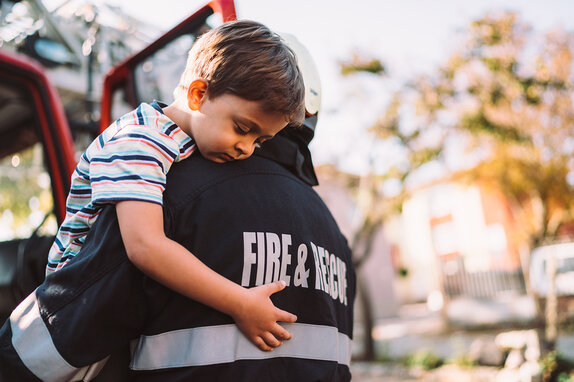
Auf Herz und Nieren geprüfte Qualität ist unsere Art, Alltagshelden Respekt zu zollen – seit über 150 Jahren.
Definitions of terms around fire hoses and their production
The fabric is woven from tear-resistant polyester yarn around the tubular inner rubber lining (manchon) - the soul of the tube. This is followed by GH Flatline vulcanization - manchon and fabric are firmly bonded.
High quality Type 1 fire hoses are made with a woven polyester jacket for light weight as well as strength and a smooth, black, low friction synthetic rubber lining. They are rugged, durable, yet flexible and easy to handle. They are used by fire departments, but also in industry.
Type 2 fire hoses are constructed with an all synthetic woven polyester jacket and also a smooth, black, low friction synthetic rubber lining. In order to type 1 hoses, type 2 hoses have an additional elastomeric coating. They are tough, hard-wearing and yet still flexible and easy to handle. The all synthetic construction makes Type 2 fire hoses rot proof and easy to clean. They are ideal for professional fire fighters, petrochemical, civil defence, major industry, marine and offshore.
In difference to type 2 hoses type 3 hoses are reinforced with a ribbed polyester jacket and nitrile-blended rubber inner lining, these are bonded together to provide better performance in abrasion resistance to prevent damage even when used in a demanding environment.
Our hoses GH TITAN 2F, GH TITAN 3F, GH TITAN COMBAT, GH TITAN X-TREME GELB and GH TITAN ATTACK are uncoated fire hoses and belong to the group of type 1 fire hoses.
Our hoses GH HERKULES 2F and GH HERKULES 3F are fire hoses like type 1 hoses plus an additianal protective outer coat and belong to the group of type 2 fire hoses.
GH fire hoses with rubberized lining and jacket are GH PROGRESS, GH PROGRESS PRO, GH PROGRESS UL, GH PROGRESS SPEZIAL UL, GH PROGRESS SUPPLY UL and belong to the group of type 3 fire hoses.
For the GH hoses of the Titan series, Gollmer & Hummel offers a simple repair kit for cuts / holes up to 4 mm.
The step by step instructions (locate - mark - glue - press - vulcanize - cool) can be found here:
Finding the right fire hose size is not always easy. Regardless of whether it's a fire hose or an industrial hose, you always want to have the important parameters for the suction or pressure hose you're looking for at hand. We offer you the interactive hose finder.
Through filters like category (quick attack hoses, indoor attack hoses, uncoated fire hoses, coated fire hoses, rubberized fire hoses. water transport hoses, forest fire hoses), operating pressure and inner diameter you will quickly find the hose you need.
With just one more click on a fire hose we provide you with all product data and your personal contact person(s)!
A hose package is primarily used to be able to quickly lay the hose reserve required for the operation. The hose package can be transported in a hose carrying basket or a hose package carrying system.
It depends on the region which fire hoses are usually used. In Asia and parts of Europe, type 1 single jacket or type 3 rubber covered hoses are popular. In North America, the double jacket construction is common.
The word hose or tube refers usually to a flexible, layflat line solution and a pipe means mostly a rigid tube. But because of the functionality sometimes is a flexible layflat hose also called flexible pipe.
The three most important characteristics of a reliable fire fighting hose are: flexibility, durability and a small bending radius / high kink resistance. Only with this features the task force can fully concentrate on fighting the flames!
Modern fire hoses have a two-layer structure: The seamless round fabric encases the inner rubber. During vulcanization, the two layers are bonded together and seal the hose. Depending on the application, a third layer - the outer rubber lining - can be added to this basic hose.
Nowadays, hoses are constructed from 2 components: The lining carries the water and the textile jacked encloses the liner and gives the fire hose its strength.
If you have any questions or If you have any questions or want to know details about GH hoses feel free to contact us! Of course, we also calculate the outlet pressure and potential pressure for you!
For certain countries there are various coupling systems, e.g. DSP for France, British Standard (BSI) for UK, NH for US, Gost for Russia and Storz for Austria, Switzerland, Denmark, Poland as well as the Netherlands. In Italy, fire departments in the autonomous provinces of South Tyrol and Trento also use Storz.
With the Storz coupling, both halves are the same and no tools are required for coupling. Its inventor is the German engineer Guido Storz. His concern at the end of the 19th century was to simplify the coupling of the hoses during an operation in order to save valuable time. Since 1936, the Storz coupling has been the standard in Germany and now also throughout Europe. It is not only used by fire departments but also in other hose applications such as agriculture.
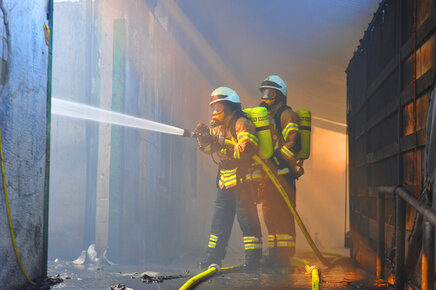
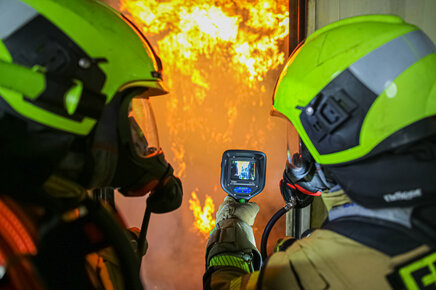
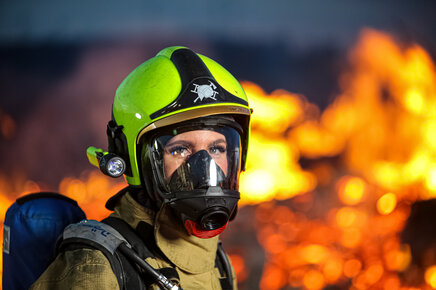
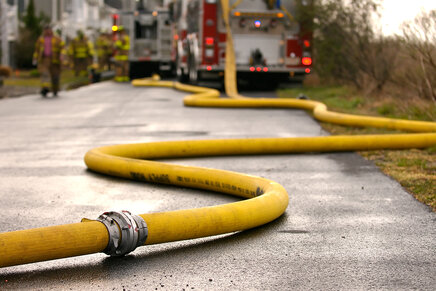
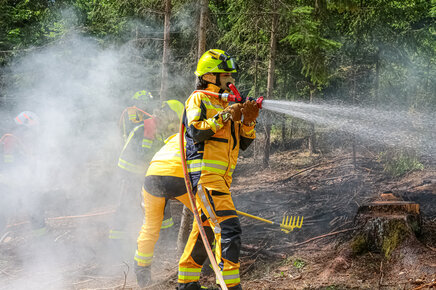

If you want to buy GH fire hose
please call + 49 07082/94 34-0 or > write us!
We will recommend you a GH dealer near you.
Learn more about the binding options and hose couplings (fittings) for fire hoses.
A hose pack is an essential piece of equipment in the fire truck. If it finds its place in the hose carrying basket, it should preferably be installed upright: When placed upright, the hose edge rubs less against the basket during travel - there are significantly fewer abrasion points than when transported lying down.
In addition, the surfaces of the hose carrier basket that are in contact with the hose should be checked regularly for sharp edges and burrs. This damage is caused by the mounted hose couplings. If you want to avoid this issue, use the GH Hose Package Carrying System!
Of course, a hose reel must be tightened to save space. However, this handle must never be done with the knee propped up or with a similarly high weight load:
At the places of operation, the ground is often rough (asphalt, pavement, etc.). Under the pressure load, damaging wear occurs on the edges of the hose.
What is the right way? If there are no smooth surfaces, the hose roll should only be tightened by hand with a light pull.
Fire hoses should always be laid without kinks. Unfortunately, this is not always the case right from the beginning. But why are kinks a big problem for the hose?
Kinks increase the pressure loss and reduce the flow rate! They are also one of the main causes of hose defects: due to the bulging of the hose at the kinked point, very strong point abrasion takes place there. If the hose moves additionally (retightening, spray shocks), this can lead to immediate failure even with new and high-quality fabric hoses.
Therefore: it is imperative to eliminate the kinks in the hose created during deployment as soon as personnel are freely available after the initial phase of the operation! And it is best to pay attention to the smallest bending radius when procuring the hose.
Packing the hose package on rough surfaces leads to high wear in the area of the hose edge and must be avoided at all costs. For this reason, only pack hose packages using the winding aids provided for this purpose (hose winding board) or on smooth surfaces. We recommend a heavy plastic tarpaulin or the smooth floor in the fire station for this purpose.
Damage to the coupling nozzle or in the binding area is one of the main reasons for hose failures. B hoses are particularly at risk due to the longer connection piece and the higher weight of the B pressure coupling. What is the remedy?
When purchasing a new hose, all hoses (including performance level 1) should be specified with a protective sleeve fitted. The small additional price provides a plus in safety for the emergency forces going ahead and significantly reduces annoying, expensive repairs to the hose collar.
When purchasing new fire hoses or repairing existing ones, make sure to use stainless steel wire for the hose cover. This has been prescribed by DIN since the end of 2014.
Protective sleeve GH HOSE-GUARD
When laying fire hoses, watch out for broken glass, nails and other sharp objects. Why is this precaution important? Due to their design, even high-quality hoses are made of a textile fabric and therefore have limited resistance to cuts, punctures and abrasions.
Falling bricks and broken window panes pose similar hazards. Where operationally feasible, fire hoses should be routed in the debris shadow of buildings as little as possible during fires. Laying of hose lines through embers and fire should be avoided.
Partially emptied hoses are particularly sensitive due to their high weight and increased susceptibility to kinking due to lack of pressure. Therefore: Always empty the hoses completely before taking them back or pulling them!
In general, pulling - even of empty hoses - should be avoided. If winding on site is not possible, the hoses should be transported away in pens.
Not only hollow jet nozzles require a minimum pressure for proper function. Fire hoses should also be operated with at least 8 bar pump outlet pressure. Why is this so? Too low a pressure promotes kinking, which leads to premature wear, pressure losses and reduced flow rate.
With practical tips and valuable info for everyday heroes.
Learn more about
